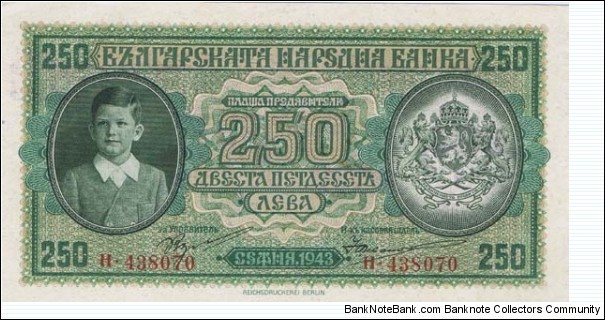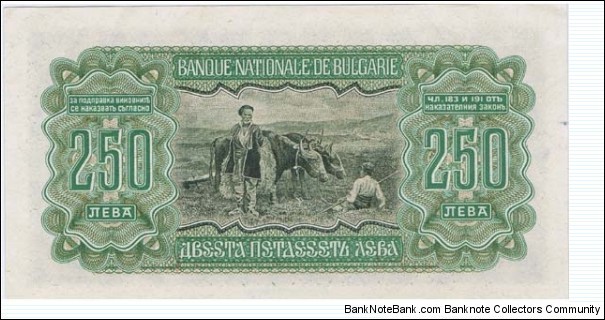-
Posts
1,361 -
Joined
-
Last visited
Content Type
Profiles
Forums
Gallery
Events
Articles
Posts posted by Saor Alba
-
-
Simeon II of Bulgaria, the child czar. He was king for 1943 to 1946


A cool note, and an interesting item bearing the image of one of only two WWII era world leaders that is still alive - the other being King Mihai of Romania. Simeon Saxe Coburgottski also has the unique distinction of having been duly elected as Bulgaria's prime minister a few years ago.
-
One of the hardest notes for me to scan.... and the colors are still off. My scanner needs to be replaced I think. The area from teh date to the womans legs on front should be a blue to red-brown transition, and the notes background should be more green, but no matter how I set or try to change later, the image is off in color. ANyhow, it's close enough.

Actually with the Joh Enschede en Zonen printed notes, the issue is less your scanner and more the way the note was printed - the colour patterns and their arrangement seem to "trick" scanners. I notice that with most Dutch printed notes I have a heck of a time scanning them - here is one I fooled with for quite a few scans and finally submitted to the fact that they are reasonably scanner deterrent:

I just cannot get the colours right. It is as though the fine geometric and colourful engravings somehow mess with the scanning software - which well - can attest to their difficulty to forge - not bad for a 90+ year old printing technique.
Even the reverse of this one doesn't image correct to the colour:

That said, I like the note - a wonderful colonial issue and tantalizingly scarce too.
-
1979 Canada 5 cents, 1987 Canada 10 cents, and some sort of gaming token.
-
Now the next question I wanted to ask is why did Malaysia uses two printers to print the same note on the same series. Any particular reason. Why didn't they use the same plate to print the notes ? Upon further examination, I realised that they even have different watermarks. The TDLR one has a small and slimmer Agung face. The BA Banknote one look very much like the Agung Portrait appearing on the banknote. Here is a list of prefixes taken from K.N. Boon catalog. As I am not familiar with Malaysian notes, I will need to seek Malaysian collectors' opinions. As what Saor Alba, it may even be a counterfeit. I am not ruling that out.
Oh monetary boards in some of the Latin American countries, like the Dominican Republic, Nicaragua etc would change printing companies like underwear. Some of it may have had to do with the fact that from time to time these countries may not have actually paid for their note orders - so they skipped town and went to another printer. So variations in design happen, I can point this out with Nicaraguan notes in the middle 1950's - they went back and forth betwixt ABNCo and TDLR - and of course printing plates are proprietary to that particular company so the new contracted company would have to do their best to re-create the design. One thing I notice with the ABNCo printed notes is that the intaglio was deeper, the inks a bit darker and the design a bit more refined than the early TDLR notes - and maybe this could explain why ABNCo lost the printing contract - more expensive.
I can only surmise that it is a similar scenario with the Malaysian note - TDLR got expensive and they went with BA, I don't doubt that Malaysia can pay it's bills in contrast to the Latin American countries though.
As for proprietary plates and designs, one exception I can think of was the Canadian Banknote Company after it was spun off from ABNCo in 1918, they continued to share stones and plates for certain designs that were historically used on Canadian Charters, even Bank of Canada notes - and some of the vignettes stones were also used on Latin American, and even Russian notes by ABNCo into the 1940's.
-
Not only is it a colour variation, but also the plates are different and you can see the differences in the details you highlighted, there is enough of a difference that suspicions would be raised about counterfeits.
-
Actually Swiss shooting medals are still being made, but IMHO they are not as nice as those from the classical era like those Holy Freres pieces.
-
I need the Italian, if I win I will let the others have the other coins.

-
A ducat defecating donkey:



This is the highest denomination of a set of notes, in the original wrapper that were sold by the city of Paderborn in Germany.
-
When I get one of these:

I will be able to add in Singapore to the beauties on banknotes collecting theme.

-
1929 Wheatie...also under the front of the machine on the floor.
I find almost as many coins under the front of the machine as in the reject bin, almost like they get spilled and not picked up.
-
Another pretty decent find to round out an exciting week with the discovery of the 1901 Indian in the cent roll on Tuesday, this time I got a 1949-S cent along with 1941, 1942, and 1959 nickels, and a 1964 YH Canadian 5 cents and a 1976 Canadian 5 cents. I don't ordinarily save Canadians unless they are YH or worth more than melt in the case of both of the 5 cent coins.
-
More cattle, looking like oxen:

That is if you can look that far to the centre of the note and peel your eyes off the distraction on left side of the note.
-
The Geico Caveman:


-
Elephants, again:

-
Lions:


-
Man and woman's best friends:


-
Sheeple:

-
Cattle:

-
Irish wolfhound:


-
Fanciful creatures from mythology:

-
Deer:

And fish:

-
A duck:

A fish:

And a Gecko, not from Geico though:

And a squirrel:

-
A shark and a nekkid lady
 :
:

-
Horses:



Latest Banknote purchases.
in Banknote Forum
Posted
A note I could love, but I like HK notes anyway.